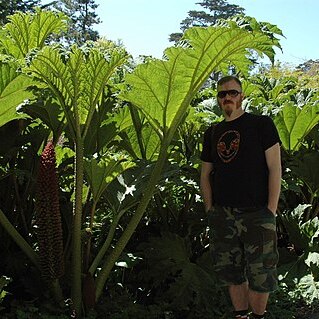Perennial stemless herbs with a creeping or erect rhizome and sometimes with dioecious flowers. Leaves borne on the rhizome, often very large, some{PAGE}{PAGE}times provided with stipule-like appendages; petiole equalling the limb or much longer; limb suborbicular, reniform or ovate, ± deeply cordate at the base, lobed, crenellate or dentate with glandular teeth, rarely entire. Inflorescences borne on the rhizome, spicate, racemose or paniculate, composed either of unisexual flowers or of distinctly protandrous hermaphrodite flowers or of hermaphrodite, ♀ and ♂ flowers, the latter being apical; bracts present or absent. Hermaphrodite flowers with calyx-tube ovoid or ± compressed, with (0–)2(–3) thick lobes; petals 2, small, or absent; stamens 2; ovary 1-locular; styles 2, filiform, subulate or compressed, papillose. Male flowers with calyx-tube reduced; styles none or rudimentary. Female flowers without petals. Fruit a nutlet or drupe, almost globose or 3-angled, coriaceous to somewhat fleshy. Seed 1, with a membranous testa. The single species occurring in the Flora area belongs to subgen. Gunnera (subgen. Perpensum (Burm.) Schindler).
Perennial scapose herbs, our species very massive, with condensed succulent suberect or rhizomatous stems. Leaves proportionally large, long-petiolate, the blade palmately veined, broadly subreniform-cordate to suborbicular, variously lobed and incised, the petiole subtended by more or less conspicuous intra-axillary or ochreate stipules. Inflorescence scapose, paniculate, racemose or capituliform, bearing numerous minute sessile, ebracteate, hermaphrodite or unisexual epigynous flowers. Calyx lobes 2, minute, persistent but seldom accrescent. Petals 2 or 0, minute when present, deciduous. Stamens 2 or rarely 1, the anther basifixed, 2-celled, longitudinally dehiscent. Ovary inferior, 1-celled, containing a single pendulous ovule; stigma lobes 2 or rarely 1, sessile, filamentous, densely papillose. Fruit a minute 1-seeded drupe.
Infl. paniculate to scapose; fls unisexual or perfect. Sepals and petals 2-3 or 0; stamens 1-2; ovary inferior, 1-celled, 1-ovuled; stigmas 2; fr. a drupe. Perennial herbs with radical lvs, extremely large to small, bearing intravaginal scales. Some 40 spp., mainly of S. America, S. Africa, East Indies, New Guinea.
Leaves usually tufted near the apex of the rhizome, often very large; leaf-laminae renifonn-cordate to ovate-truncate, simple to lobed, crenate to compound-dentate, rarely entire, palmatinerved; petiole equalling or longer than the lamina, sometimes provided with ochrea-like cataphylls.
Flowers ebracteolate, bisexual or unisexual, monoecious or polygamous (male flowers towards the apex and female ones towards the base, sometimes hermaphrodite in between) or dioecious.
Lamina palmately veined, small or enormous and rhubarb-like. Infl. small to very large, of very small insignificant fls. Fr. variously coloured white to dark red.
Gynoecium 1-locular; styles 2, filiform, subulate or compressed, entirely papillose.
Inflorescences scapigerous, spicate, racemose or paniculate, borne on the rhizome.
Petals 2, small, longer than and alternating with the calyx-lobes, or absent.
Male flowers with calyx-tube reduced and styles vestigial or absent.
Perennial herbs, sometimes giant, with a creeping or erect rhizome.
Fruit an indehiscent nutlet or a ± globose to trigonous drupe.
Calyx-lobes 2(3), equal or unequal, or absent.
Stamens 2, oppositipetalous, or absent.
Seed 1; testa membranous.
Female flowers apetalous.

